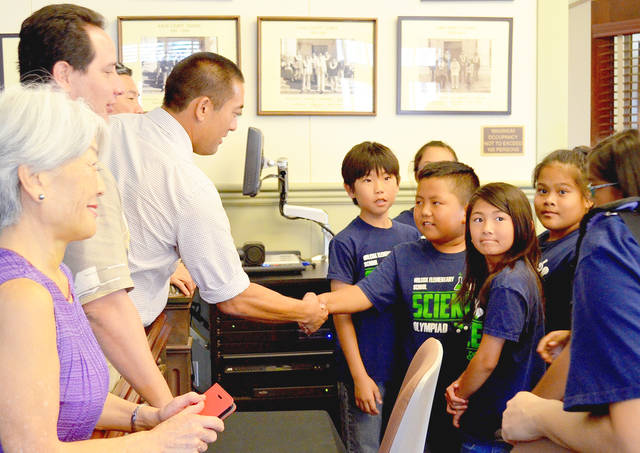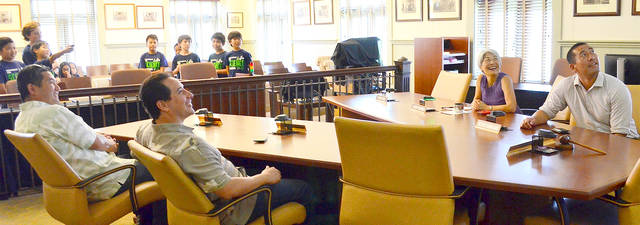LIHUE — Tiny houses, teleportation devices and a reverse vending machine that would serve as a conduit for recycling were among some of the ideas presented recently to the Kauai County Council by Wilcox Elementary students.
Describing different styles of tiny houses, Neva Leong, 11, who lives in Kapahi, and Trey Nakamura, 9, of Lihue, said tiny houses are a good solution to the housing crises because they’re small, inexpensive and take up less space.
Both students said they’d live in tiny houses.
Councilmember Arryl Kaneshiro asked where the students would suggest building tiny houses.
“Grove Farm has a lot of land and if they managed to have older houses taken out and rebuilt and have more tiny houses fit where that one house fit,” Leong said.
Kaneshiro said he liked the idea of building tiny home communities where older homes once stood because the infrastructure would already be in place.
“You can just put a smaller house there, rather than putting it on land that hasn’t been developed yet you have to bring and spend money to get water and sewer and other utilities out there. Good answer,” he said.
Teleportation, said Matthew Estrada, 10, of Lihue, will help solve the traffic crises, because they’re fast. They work, he said, when you go into one you disappear and then reappear in another one at a chosen destination.
Though he’s still working on the prototype for his design, Estrada said teleportation devices would cost consumers about $50,000.
“Teleporters, technically, however far you want to go, that’s how long it takes you like maybe if it’s five miles away it takes like five seconds, if it’s 20 miles away it’ll take you like 15-20 seconds. It depends on how many miles away, that’s how many seconds it takes,”
Kaneshiro said he wanted to be the first person to try the teleportation machine.
One day when 10-year-old Luke Gandeza from Lawai was sitting in traffic, he looked out the window of his vehicle and noticed there were a lot of electrical cables on Kauai and that’s when it hit him: cable cars.
Gandeza told the council, cable cars would be another way to solve Kauai’s traffic problem.
“It’ll go above traffic and cables go everywhere, so they can go everywhere,” he said.
To complete the project, he said the county would have to reinforce the cables, poles and purchase the cable cars, that, he said, would cost them about $5 million.
“My idea was computerized traffic lights,” said Rees Jenkins, 11 of Puhi. “They’re computerized for the congested lanes, so the congested lanes go and the non-congested lanes wait for the lanes to go.”
Councilmember Derek Kawakami said he liked the student’s ideas on how to solve Kauai’s traffic issues and said some of their ideas are already being implemented.
“Like the optimization of our traffic signals. That’s already being worked on as well. I can tell you roundabouts where they have four-way intersections, roundabouts are good, because they slow vehicles down, but keep traffic going,” he said.
Recycling is important, a third group of students told the council, because without it, the island’s landfills fill up. Trash also puts animals at risk, which is why they came up with a fun way to encourage recycling.
“We were searching up innovations for recycling and I found something on the internet that said something about reverse vending machines, so we innovated that,” said Johnray Salud, 10.
The vending machines would work by accepting recyclable materials such as can and bottles.
“Whenever we put anything recyclable like a can or bottle (in the machine), like about 10, you’d see a cross and then you’d get to play a game and if you win that game, you’d get to earn a prize,” he said.
The prizes, he said would probably be a toys like Rubik’s Cubes or teddy bears, because the machine aims at kids.
Heiley Kikuchi, 10, said recycling is important because if people don’t recycle, it will destroy the environment and kill off birds, trees and native plants.
Councilmember JoAnn Yukimura asked the students how they would recycle a car.
“Did you know Toyota, I believe, is making a totally recyclable car? I haven’t kept up with it, but they’re making it so all of the parts can be used again and nothing goes into the landfill, which is sort of your idea, on a much larger scale,” she said.




Did you know that, I think it is every car/vehicle, has been recyclable, like, forever?
” parts can be used again “. This is new?
Does the county promote this with their vehicles?
Think about this one JoAnn. The island has enough ” stored ” vehicles do you really want more.
” nothing goes into the landfill ” Where do these used parts go and live? Indoors? The beach? There are people living in the bushes yet we should build storage for car parts that may never get used again?
Did you know that Toyota was one of the pioneers in changing production monthly so parts were NOT interchangeable. Making it harder to reuse most parts.
I have never bought a new car, washer, dryer or many many other very reusable items. ( and easily repaired ) How about you JoAnn?
In Vancouver BC recently I noticed that their contraflow is managed with signal lights instead of setting up cones each day. Must save a lot of money. Drivers know the center lane is open by a green “x”. It works very well even at speeds around 100 kph (60mph). I wonder how much money we’ve expended having the crew set up and take down the cones each day for the past 28 or so years…
Smart kids. Good session. Thanks for the good news.